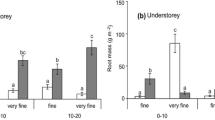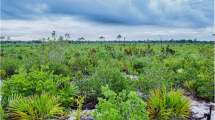Abstract
Relic charcoal hearths are prevalent throughout the Appalachian Mountains as reminders of the wood charcoal era and are evident today by the characteristics of forest stand structure, composition and understory vegetation. The importance of the soil resource to the stability and recovery of these anomalies in the plant community is not well understood. This study was conducted to compare forest floor and soil chemical properties, and vegetative characteristics on relic charcoal hearths to adjacent, non-hearth areas. Overstory tree cover and density was significantly lower on hearths than for adjacent areas. Overstory richness and diversity were consistently, but not significantly, lower on hearths, as were density and species richness of understory and ground vegetation. Little difference between hearth and adjacent forest floor properties was observed; however, soil calcium concentrations, pH. and percent carbon were higher on hearths, and phosphorus concentrations were generally lower. We discuss the effects of releasing large amounts of base-forming cations through repeated use of the hearths and the subsequent long-term effects on soil fertility and vegetative development.
Similar content being viewed by others
References
BiondiniM. E., BonhamC. D. & RedenteE. F. 1985. Secondary successional patterns in a sagebrush (Artemisia tridentata) community as they relate to soil disturbance and soil biological activity. Vegetatio 60: 25–36.
BremnerJ. M. & MulvaneyC. S. 1982. Nitrogen-total. Methods of Soil Analysis. In: PageA. L. et al. (eds). Agronomy No. 9. Part 2 Amer. Soc. Agron., Madison, WI. p. 595–622.
Burns, R. M. & Honkala, B. H. (editors). 1990. Silvics of North America. Vol. 2. Hardwoods, USDA Forest Serv. Agric. Handb. 654: 877 p.
Day, R. K. 1959. Forests follow the charcoal burner. The Primeval Forests of the Allegheny Plateau. In: Beatley, J. C. (ed.). Bull. Ohio Bio. Surv. 1: 182. p.
EmrichW. 1985. Handbook of charcoal making: The traditional and industrial methods. Solar Energy R & D in the European Community. Series E, Energy from Biomass. Vol 7. D. Reidel Publ., Boston, MA. 277 p.
Garcia-MontielD. C. & ScatenaF. N. 1994. The effect of human activity on the structure and composition of a tropical forest in Puerto Rico. For. Ecol. Manage. 63: 57–78.
LutherE. T. 1977. Our restless earth. Univ. of Tenn. Press, Knoxville, TN. 94 p.
MacCleeryD. W. 1993. American forests: A history of resiliency and recovery. The Forest History Society, Durham, NC. 58 p.
MargalefR. 1951. Diversidad de espicies en las comunidades naturales. Publ. Inst. Biol. Apl. Barcelona. 9: 5–27 (English summary).
McCureB. 1991. Multivariate analysis on the PC-ORD system. Dept. Of Gen. Sci., Oregon State Univ., Corvallis, OR.
McLeanE. O. 1982. Soil pH and lime requirement. Methods of Soil Analysis. In: A. L.Page, et al. (eds). Agronomy No. 9, Part 2. Amer. Soc. Agron., Madison, WI. p. 199–223.
MengelK. & KirkbyE. A., 1987. Principles of plant nutrition. Intl. Potash Inst. Bern, Switzerland. 687 p.
Mikan, C. J. 1993. Edaphic properties relating to altered succession on historic charcoal hearths in Pennsylvania. M.S. Thesis. Pennsylvania State University, State College, PA. 67 p.
MikanC. J., & AbramsM.D. 1993. Altered forest composition and soil properties of historic charcoal hearths in southeastern Pennsylvania. Can. J. For. Res. 25: 687–696.
OliverC. D. & LarsonB. C. 1990. Forest stand dynamics. McGraw-Hill, Inc., New York, NY. 467 p.
Phillips, E. A. 1959. Methods of vegetation study. Henry Holt and Co., Inc. 107 p.
PritchettW. L. & FisherR. F. 1987. Properties and management of forest soils. John Wiley and Sons, New York, NY. 494 p.
ShannonC. E. & WeaverW. 1949. The mathematical theory of communication. Univ. of Illinois Press. Urbana, IL. 117 p.
ThomasG. W. 1982. Exchangeable cations. In Methods of Soil Analysis. PageA. L. et al. (eds). Agronomy No. 9, Part 2. Amer. Soc. Agron., Madison, WI. p. 159–164.
TryonE. H. 1948. Effect of charcoal on certain properties of forest soils. Ecological Monographs 18(1): 82–115.
WaringS. A. & BremnerJ. M. 1964. Ammonium production in soil under waterlogged conditions as an index of availability. Nature. London. 201: 951–952.
Author information
Authors and Affiliations
Rights and permissions
About this article
Cite this article
Young, M.J., Johnson, J.E. & Abrams, M.D. Vegetative and edaphic characteristics on relic charcoal hearths in the Appalachian mountains. Vegetatio 125, 43–50 (1996). https://doi.org/10.1007/BF00045203
Received:
Accepted:
Issue Date:
DOI: https://doi.org/10.1007/BF00045203




